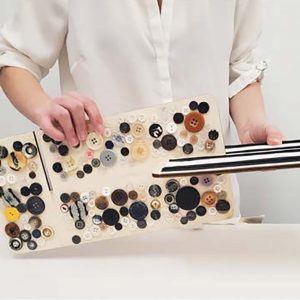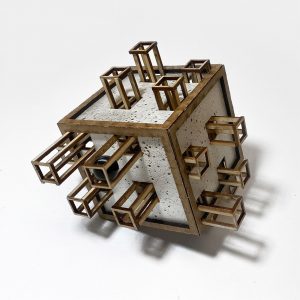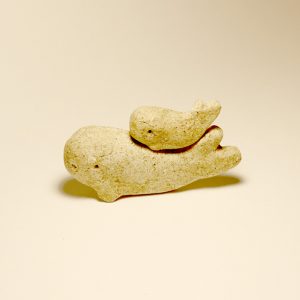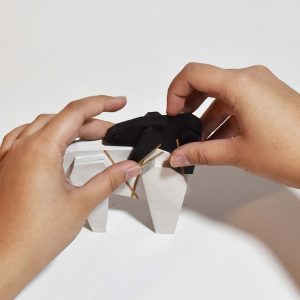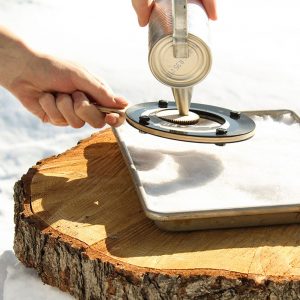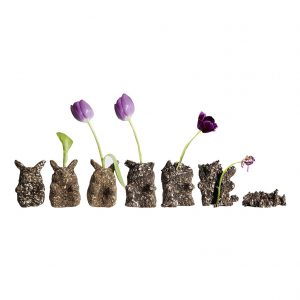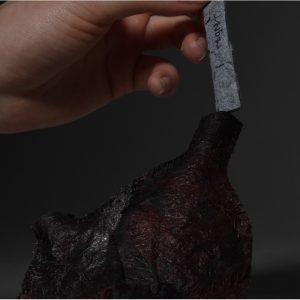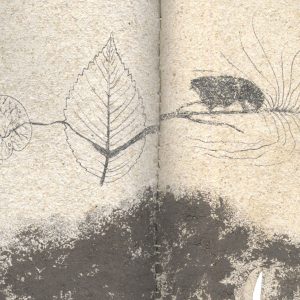
We are pleased to announce YEE-O 2020 – Year End Exhibition – Online edition for this 2019-2020 academic year. This annual event celebrates the hard work and creative achievements of over 500 undergraduate and graduate students from every unit and level in the Faculty of Architecture at the University of Manitoba. Unfortunately, COVID-19 led to the cancellation of this in-person event, but sharing and celebrating student achievements must go on!
P5 AFTER | MATERIAL
Instructors: Mohamad Araji, Jae Sung Chon, Katherine Isaac, Leanne Muir, Alyssa Schwann, Kim Wiese
“Toys are not really as innocent as they look. Toys and games are preludes to serious ideas.” Charles & Ray Eames.1
“Material itself is dead and lifeless. It is only given life by form, breathed into it by the creative will of the artist.” Walter Gropius. 2
“Efficiency depends on the trinity of material, shape and the process of making. The lighter that constructions have to be, the more critical the balance between these three.”
Adriaan Beukers. 3
Inquiry: What are the roles of materials in our environment, against the backdrop of sustainability, and as related to design? How do specific material functions determine form, experience, and meaning in such contexts? What is well-designed? Can our understanding of well-designed encompass the lifecycle of that which we design? How does a designer develop an idea in reference to (what kinds of) conditions and contexts? Can the presence of material (and its materiality) be modulated through technology, aesthetics, play, human factors, and promotion?
What are the visible/invisible qualities within our designed concepts? Can we (re)engage those qualities through material modulations? If so, how (how far)? How (how much). Can we affect our living through play, and how (how much) can the experience be affected by materiality and its purposeful modulation? What are the critical elements and agencies of such modulation?
Can we animate the inanimate through colour, pattern, texture and shape, among other mediums? Can inanimate material evoke imaginations, emotions, and memories to animate our experiences?
Amaurotic
Barak Al Dabous, Juliana Anderson & Kaylee Peters
Amaurotic, meaning partial or total loss of sight, was designed for children who are blind or visually impaired. The groups design studies and research led us to be inspired towards an inclusive design, that addressed certain attributes of toys beyond visual aesthetics and more towards something that is not only accessible and usable by a certain demographic or group of people. Amaurotic pushes the imagination and creativity of anyone who interreacts with it, as the modular pieces allow for one to build endless structures and forms, while simultaneously learning. The process of designing this toy has been very inspiring to the group to learn more about the importance of inclusivity in not only toy design, but the design of the everyday. The lack of consideration of inclusive toy design today inspired the group to greatly carry this challenge of designing a toy for children who face great challenges in all facets of design.
MEIRO
Hakeem Amoo, Jairo Nato & Holly Santiago
Meiro is a toy maze with simple mechanics, a self-regulating fidget tool that helps people focus. Inspired by Kanawa’s maze temple, commonly known as Ninja-dera, the maze’s goal is to help the ninja (ball) find the exit to the temple (maze). The maze is essentially an enclosed hollow box and paths that are made by non-intersecting slots in three axis points. Its primary materials are MDF (exoskeleton for box and slots) and gelatin bioplastic (screen). We explored different kinds of bioplastic including corn starch, potato starch, and agar-agar based bioplastic, however, opted for gelatin for its see-through finish and its adhesive properties that hold its form together.
The Birds
Aliyah Baerg, Sabba Rezai & Katerina Toews
This project explored the material qualities of bananas, modulating them through iterative testing to produce a bio- based textile with leather-like qualities.
Masks were selected as the focus due to their imaginative qualities, versatility, and open-ended quality of play. The bird characters stand as representation of distinct character qualities, inspired by poetry and literature, acting as an intermediary between time and place.
The leather material provides lightness and a sense of ethereal temporality, returning gently to the earth once it’s served its purpose.
Polysai
Newell Belamide, Melody Long & Nice Rugay
There is curiosity to the qualities of a simple tree. Different points of growth in trees could relate to different segments of people’s lives determined with specific characteristics of that specific tree from its size, spread of growth, the form or shape, and the age; different qualities could be defined through these factors. In this project, relating to these qualities we turn them into different components of which you can relate to in a unique form of which a tree made naturally. It has potential to create something related to the play, inspirational to the viewer, and appreciation for the relationship that was made with the qualities of the tree and the experiences one may had shared with the characteristic of the tree.
After | Material
Vienna Castanaga, Angeline Reyes & Orrie Lemieux
An interactive toy composed of basic shapes and different textures that engages the user’s imagination and creativity through different combinations and connections. The toy was designed to respond to the needs of Florence, the character narrative created for this project. The different shapes and textures were acquired based on thorough analysis of each materials: limestone, willow wood and leather. Using organic material in designing the toy provides a more cyclical life cycle and the toy is more environmentally friendly. The concept of the toy is based on the loose parts theory. Loose parts are composed of materials that can be moved, combined or connect in multiple ways which provides a wider range of opportunity in play.
The Icarus Flyer
Dallin Chicoine, Sean Kohli & Brenden Nemeth
An interactive toy composed of basic shapes and different textures that engages the user’s imagination and creativity through different combinations and connections. The toy was designed to respond to the needs of Florence, the character narrative created for this project. The different shapes and textures were acquired based on thorough analysis of each materials: limestone, willow wood and leather. Using organic material in designing the toy provides a more cyclical life cycle and the toy is more environmentally friendly. The concept of the toy is based on the loose parts theory. Loose parts are composed of materials that can be moved, combined or connect in multiple ways which provides a wider range of opportunity in play.
Floaties
Alyssa Cole, Jeanine Milana, Adinna Vergara & Kerui Zhang
Floaties utilizes the natural healing qualities of oats, rice, and chamomile in a playful and soothing, environmentally friendly bath toy, designed to relieve dry, itchy skin. Designed using a mixture of finely ground oats and rice glue, Floaties is intended to be single use, dissolving in bath water to release beneficial saponins into the skin, while safely draining out of the tub and back into the environment. The pair of whales emulates a family bond between adult and child, as bath time is often beneficial one-on-one time during child development.
Luna & Shadow
Brooke de Rocquigny, Nicholas Epp, Jenn Laird & Derelyne Raval
Luna and Shadow are intended to be a minimalist toy for anyone ages 6 and up. Their simplicity in material and function allow them to be enjoyed by people of all ages. The concept of bear was chosen as it is a familiar and comforting figure with a long tradition of being used in toys.
The form was generated by identifying primary and secondary outline from the polar bear. These shapes evolved throughout the design process as functional geometric needs were identified in order to fit the bears together.
Luna and Shadow are delivered in an igloo shaped box of two forms, which can detach and allow for multiple arrangements which Luna and Shadow can climb on.
Taffigraph
Jia Garcia, Adetola Obafisoye & Owen Swendrowski-Yerex
The intention of the project was to create a drawing toy made with materials that are not as commonly used anymore and could easily be found. Made from upcycled materials such as vinyl records and scrap metal, Taffigraph produces a maple taffy candy with a spirograph-like pattern. Two versions were created to accommodate single person use and multiple person use.
Super Nova
Mackenzie Jackson, Taylor Kulczycki & Joseph Olisa
Both as object and effect Super Nova acts as a catalyst for re-imagining the potentials of play theory. Upcycled CD’s were used as they take an estimated one million years to decompose and as we move towards an increasingly wireless world, there is an abundance of this material. By arranging the CDs on a spinning mechanism, and exposing them to light, the latent colours and qualities are revealed.
Bunny Sprout
Nadine Lowden, Liam Wong & Carrie Zhou
Bunny Sprout, made from Bio Sculpt, is an engaging and interactive toy designed to help kids explore and experience growing plants from seed for the first time. Bunny Sprout is a small bunny rabbit molded from an upcycled and compostable material. Inside the bunny is space to place a flower bulb, following which the whole bunny can be planted inside or outside. As the form breaks down and the flower grows, ingredients of the material decompose as fertilizer.
The intended audience for Bunny Sprout is children aged 5-10. Ideally, use would change over time, from a 5 year old experiencing the magic of growing things for the first time to a 10 year old who is more invested in their own plants, and perhaps collects multiple Bunny Sprouts to create their own garden.
After Material
Shaelynn Lukey, Shane Patience & Kaitlin Windrem
Music is emotion, expression, communication and understanding. An instrument cannot be imagined without also imagining its creator and the level of skill, discipline an patience needed to achieve what has become a timeless craft. Upcycle Sound pays homage to this craft. In a time when sought after materials used in instrument construction are becoming endangered or extinct the need for a new sustainable and affordable material is necessary. Canadians consume and waste around 310 kg of cardboard per year when a singe standard size cardboard box can produce an instrument capable of evoking emotion, memories and imagination. This instrument production is achievable with a particular combination of cardboard, corn syrup, corn starch and vinegar.
Fill me With Joy
Nick Lupky, Aynur Omar, Alexa Yasinski
“Fill Me With Joy” was a project that transformed completely biodegradable materials into a fun and educational toy. An orange peel and pine blend was used to make a seed-storing and dispersing pod. Paper-mzache techniques were used to make a hollow, round base while recycled plastic nets were used to imprint unique patterns on each pod. Milk paint was used to coat them, and seeds were added to the coating. Drilled holes and a cork allowed for seeds to be collected, stored, shaken, and dispersed in a garden.
The Confessional
Jas Singh, Teagan Vincent & Taisha Warbanski
The Confessional is made up of lint – for its flammability, bio-plastic – for its structure, and avocado dye – for its colour. The Confessional is a ritual cleansing toy intended to bring peace when entering a new year. On lint paper, regrets and poor experiences are expressed and then stuffed away within The Confessional. On December 31st The Confessional is set on fire and with it the past years bad experiences. The Confessional burns and the cleansing begins, as does a new year, free of the past.
Dis-Jointed
Kara Tinkler
Dis-Jointed is a zine based off the processes and outcomes of P5, Material | After, it depicts the process to make a puzzle cane. The zine is made of handmade recycled paper and elmwood fibres, bound by a dowel and hemp string. The focus of this project is the materials used; the handmade paper was not utilized in the final outcomes of P5 but was utilized in a zine about its process. Due to Dutch elm disease in Winnipeg there are many elmwood trees being cut down, lowering this material embodied energy and repurposing paper that could end up in the landfill.
1 https://www.eamesoffice.com/blog/five-things-charles-ray-eames-teach-us-about-play/
2 Walter Gropius.The New Architecture and the Bauhaus, 1935.
3 Beukers, Adriaan, Ed Van Hinte, Lightness – The inevitable renaissance of minimum energy structures, 010 Publishers, Rotterdam,1998.

